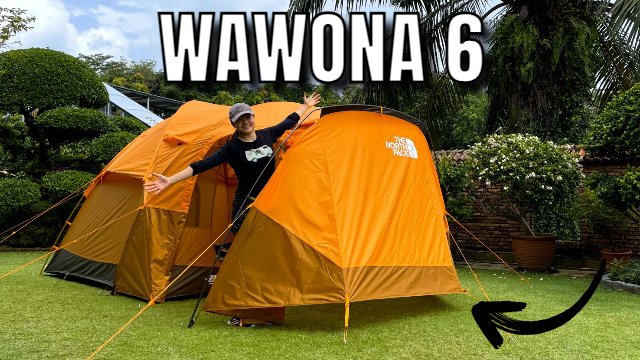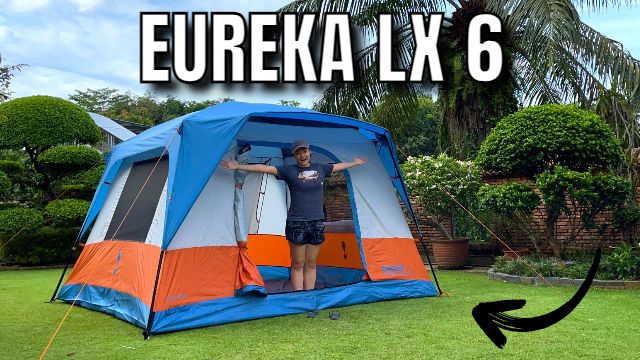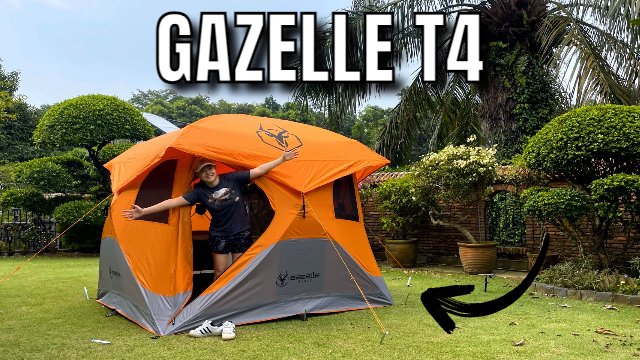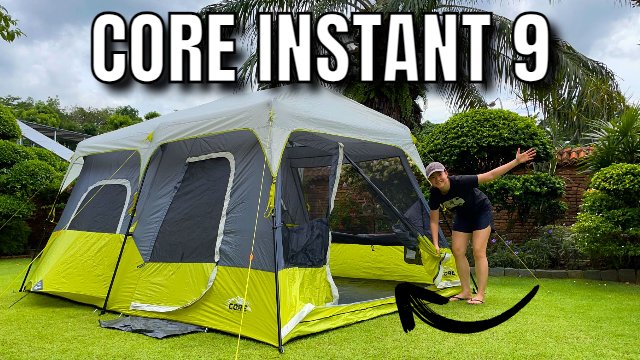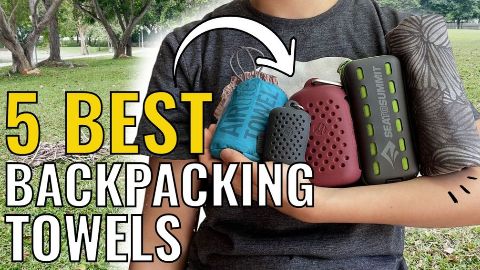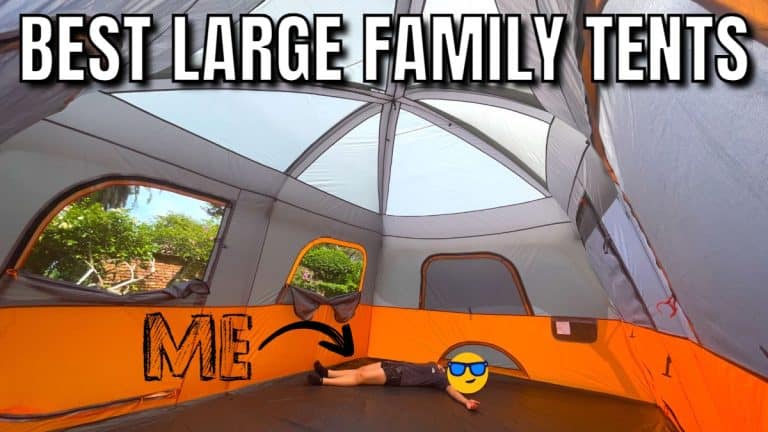The 9 Best Family Camping Tents (Bought & Tested!)
Over the past 4 years, I’ve bought and tested over 30 different family camping tents, and for this review, only these 9 best family tents made the cut:
The North Face Wawona 6
REI Base Camp 6
REI Wonderland 6
Eureka Copper Canyon LX 12
Gazelle T4-T8 Hub Tent
Gazelle T4 Plus Hub Tent
Core Equipment Instant 9
Coleman Sundome 6
Core Equipment Cabin 10
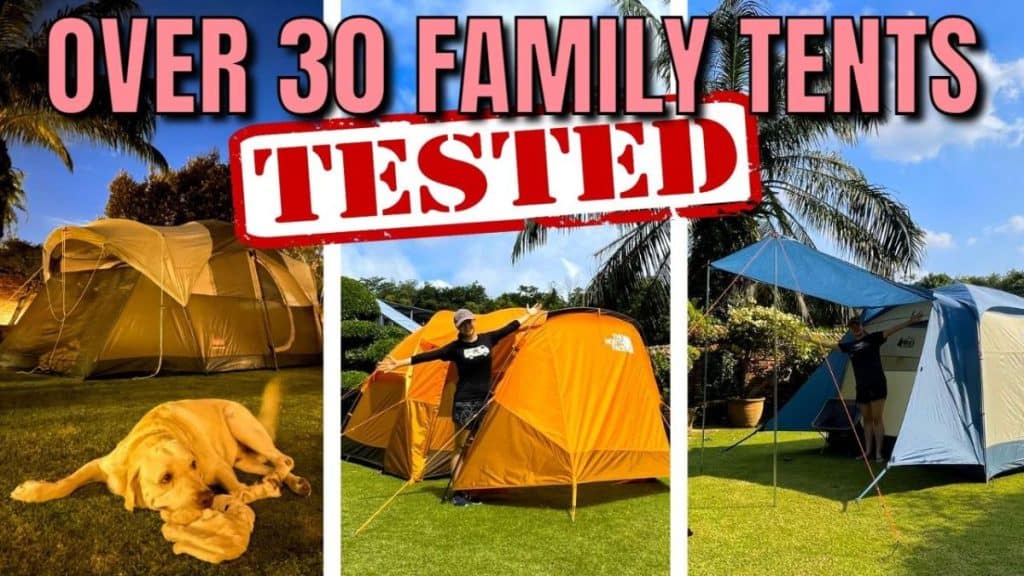
Best Family Tents – Quick Summary
This page contains affiliate links, and that means that I may earn a commission if you buy something, at no extra cost to you. You can find my full disclosure policy here.
Here’s a quick summary of all the family camping tents that I recommend (after buying and testing, of course).
| Tent | Recommendation | Score | Price |
|---|---|---|---|
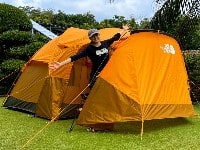 |
BEST OVERALL The North Face Wawona 6
|
||
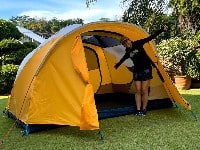 |
RUNNER-UP REI Co-Op Base Camp 6
|
||
 |
BEST FOR LARGE GROUPS Eureka Copper Canyon LX 12
|
||
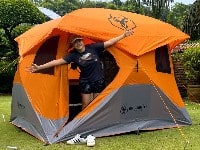 |
BEST INSTANT SETUP Gazelle T4/T8
|
||
 |
BEST BUDGET PICK Coleman Sundome 6
|
Here’s why you can trust me – The 9 best family tents in this review have cost me almost $2,700, and that’s not even including the other 20+ family tents that didn’t make it into this review. (Altogether, I tested over 30 family tents!)
I also spent at least a week in each tent, so that’s a good 30 weeks (or 7 months!) of testing right there.
If you prefer watching to reading, check out my YouTube video right here. Instead of only the 9 best family tents, I listed a whopping 16:
But if you prefer reading, I’ll take you through my detailed recommendations right now.
- Best Family Tents – Quick Summary
- 1. The North Face Wawona 6 (Overall Best Family Tent & Best Weather Protection)
- 2. REI Co-Op Base Camp 6 (Runner-Up & Best Off-Season Family Tent)
- 3. REI Co-Op Wonderland 6 (Best for Fair Weather)
- 4. Eureka Copper Canyon LX 12 (Best Large Family Tent)
- 5. Gazelle T4-T8 Hub Tents (Best Instant Family Tent)
- 6. Gazelle T4 Plus Hub Tent (Best Screen Room Tent)
- 7. Core Equipment Instant Cabin 9 (Best Budget Instant Tent & Best Large Instant Family Tent)
- 8. Coleman Sundome 6 (Best Budget Family Tent)
- 9. Core Equipment Straight Wall Cabin 10 (Tallest Family Tent)
- Other Best Family Tents on my Wish-List
- How I Tested the Best Family Tents
- Why You Can Trust Me
1. The North Face Wawona 6 (Overall Best Family Tent & Best Weather Protection)
Key Info
Peak height: 77 inches
Inner tent area: 75.7 square feet
Vestibule area: 51.0 square feet
Setup timing (1P): 20 minutes
Packed size: 26 by 16 by 10 inches
Weight: 19.4lbs.
Pros and Cons
Summary
One question that I often get asked by my YouTube viewers is this – “What is the best family tent you’ve ever tested?” And my answer to this question almost always is – “The North Face Wawona 6“. Here’s exactly why I love it so much.
First up, when it comes to weather protection, the Wawona 6 was the only family tent that I managed to put through a whopping 3 days of heavy afternoon rain. It was so heavy that my entire yard flooded, the bottom of the tent was completely underwater, and it didn’t even leak at all.

I also put my Wawona through 15 mile-per-hour winds, and it held up completely fine cos I had it all guyed out.
The Wawona has the most guylines (a whopping 11 guylines) of any dome-shape family tents here, plus the highest quality DAC MX aluminum poles, so naturally it’s the best against wind. Here’s how the Wawona compares against some other family tents that I’ve tested:
| Family Tent | Guylines | Poles |
|---|---|---|
| The North Face Wawona 6 | 11 | DAC MX |
| REI Base Camp 6 | 6 | Aluminum |
| Coleman Sundome 6 | 6 | Fiberglass |
Second, the Wawona also has the best vestibule of any of the tents in this review. If you’re looking to take your family tent through some serious rains, this vestibule storage space is a great feature to have, especially for storing wet gear and dirty shoes.
| Family Tent | Inner Tent | Vestibule | Total Area |
|---|---|---|---|
| WeatherMaster 10 | 143.6 | 0 | 143.6 |
| Columbia 10 | 138.0 | 0 | 138.0 |
| Outdoor Products 10 | 135.8 | 0 | 135.8 |
| Core Cabin 10 | 135.8 | 0 | 135.8 |
| Base Camp 6 | 82.5 | 52.4 | 134.9 |
| Wawona 6 | 75.7 | 51.0 | 126.7 |
| The Others | 60.6-126 | 0 | 60.6-126 |
Only 2 tents in this review have vestibules (the Wawona 6 and Base Camp 6), but the livability in the Wawona is way better than the Base Camp’s.
I could stand up in the entire vestibule, because the lowest height of the vestibule was still a whopping 65 inches (a little taller than my height).

On top of that, I could even fit 2 camping chairs with lots of leftover vestibule space for a camping table too. Essentially, there’s loads of space for loads of camping furniture.
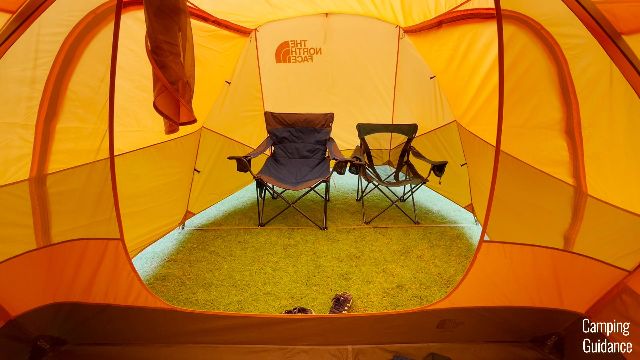
As for the Base Camp, while the front vestibule could fit only 2 chairs, the back vestibule couldn’t even fit one chair, so there’s much less livability.
Third, the Wawona also offers great value for money as a premium, higher-end tent. Take a look at the different 6-person tent options from great tent brands:
| Family Tent | MSRP |
|---|---|
| The North Face Wawona 6 | $500 |
| Nemo Aurora Highrise 6 | $500 |
| Big Agnes Bunk House 6 | $700 |
| MSR Habitude 6 | $700 |
Notice that only The North Face Wawona and the Nemo Aurora Highrise are more affordable? And I went for the Wawona over the Aurora because of the humongous vestibule.
One small con to take note of here is that this tent’s interior space is the smallest I’ve ever seen in a 6-person tent. You can technically fit 6 people, but I recommend fitting a maximum of 3 to possibly even 4 adults. Here’s what 6 single sleeping pads looks like:
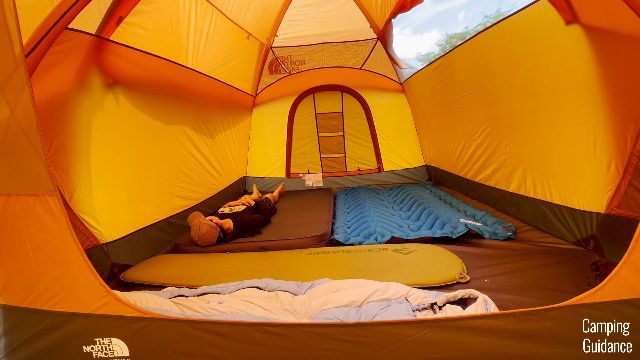
Check out the Wawona 6:
2. REI Co-Op Base Camp 6 (Runner-Up & Best Off-Season Family Tent)
Key Info
Peak height: 73 inches
Inner tent area: 82.5 square feet
Vestibule area: 52.4 square feet
Setup timing (1P): 17.5 minutes
Packed size: 28 by 13 by 9.5 inches
Weight: 20.6lbs.
Pros and Cons
Summary
The REI Co-Op Base Camp 6 serves one main purpose that the Wawona 6 doesn’t – It’s a great off-season (or 3+ seasons) camping tent, while the Wawona is purely for 3-season summer camping.
Look at how much mesh there is on the Wawona:

In fact, you’ll find that most tents in this review are summer tents, and the REI Base Camp 6 is my only 3+ seasons tent in a family size.
It’s also my only family tent that has a full-length rainfly, which extends all the way down to the ground. (Btw, the Wawona has only a partial rainfly.) So, this Base Camp got through my 1-hour heavy rain test with no leaks at all.
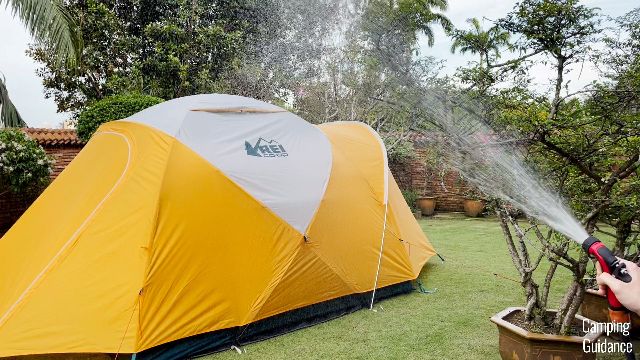
I also really liked how the full rainfly fits very nicely over the inner tent, and I checked – the rainfly doesn’t touch the inner tent walls at all, so I had no condensation issues with this tent.
This, coupled with the large amount of fabric to mesh ratio on this tent, makes it the perfect family tent for camping in the off-season with colder temperatures.
On top of this, I also really appreciated the two vestibules, they’re pretty big in size, the back vestibule can fit quite a bit of gear (but no chairs), and the huge front vestibule can easily fit 2 camping chairs.

Admittedly, they’re not quite as livable as The North Face Wawona’s humongous vestibule, but that’s still way more floor space for gear than the rest of the family tents in this review.

And that’s not all. The Base Camp also has a mind-boggling number of storage options. Remember, this is a 6-person tent, but I got a whopping 14 pockets all around the tent to store gear, and 20 loops to hang tons of stuff.
| Family Tent | Pockets | Loops | Total |
|---|---|---|---|
| Base Camp 6 | 14 | 20 | 34 |
| Wawona 6 | 9 | 8 | 17 |
| Wonderland 6 | 8 | 7 | 15 |
| Eureka LX 6 | 6 | 5 | 11 |
| Caddis 6 | 7 | 1 | 8 |
| Gazelle T4 | 7 | 0 | 7 |
| The Others | 2-4 | 2-4 | 2-6 |
None of the other family tents in this review even come close to what the Base Camp offers in terms of storage.

However, I wouldn’t recommend buying this Base Camp if you’re mainly a summer camper.
Especially with the rainfly on, it can get a little bit hot and stuffy during the summer.
And even with the rainfly off, there’s not a whole lot of mesh, with just 2 not-too-big windows, and a rather tiny skylight, compared to other tents.
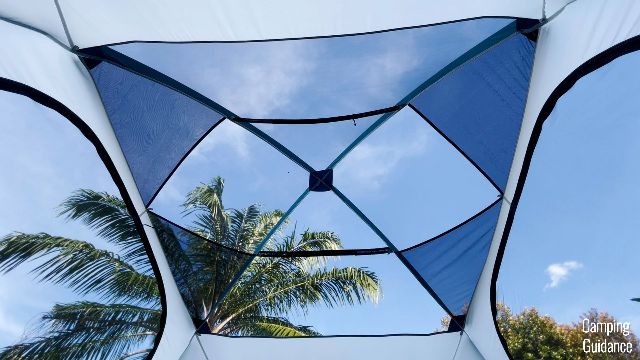
Important Pro-Tip: Essentially, go with the Wawona if you’re a summer camper, and the REI Base Camp 6 if you’re an off-season camper.
Will this work for winter camping? Possibly, if you’re able to insulate your tent well. Just take note that REI lists this as a 3+ season tent, not a 4-season family tent (though I have seen friends using this in light snow).
Check out the Base Camp 6:
3. REI Co-Op Wonderland 6 (Best for Fair Weather)
Key Info
Peak height: 81 inches
Inner tent area: 82.5 square feet
Vestibule area: None
Setup timing (1P): 19.5 minutes
Packed size: 30 by 15 by 10 inches
Weight: 23.6lbs.
Pros and Cons
Summary
If you skipped past both the Wawona (#1) and the Base Camp (#2) because they’re both dome tents and not quite as roomy as you would have liked, well, you’re in luck, because the REI Co-Op Wonderland 6 is the best cabin tent I’ve tested so far, and it has such a roomy interior.
This is the family tent with the best lowest height at its 2 left and right sides, coming in at a whopping 76 inches.

No other family tent even comes close.
| Family Tent | Lowest Height |
|---|---|
| REI Wonderland 6 | 76 inches |
| Caddis 6 | 68 inches |
| Gazelle T4 | 67 inches |
| Eureka LX 6 | 66 inches |
| Core Cabin 10 | 65 inches |
| Core Instant 9 | 64 inches |
| Columbia 10 | 62 inches |
| The Others | 39-61 inches |
And the center peak height comes in at about 81 inches, so basically, I got the peak height (give or take a few inches) across the entire length of this Wonderland.
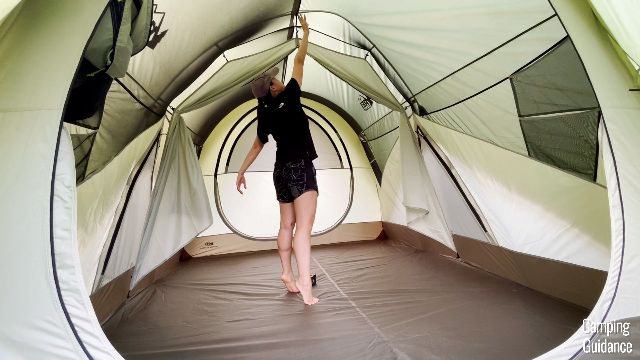
On top of that, the Wonderland also has the maximum amount of mesh possible for summer ventilation.
The mesh doesn’t just cover only the ceiling, it extends down the sides of the tent as well, and I think easily more than half the tent is covered in mesh.

Meanwhile, none of the other tents in this video have mesh that extends beyond the ceiling of the tent.
Here’s a table summarizing my thoughts on the mesh to fabric ratio in each family tent. These are just estimations, but I did my best to measure any windows, vents, and ceiling mesh in each tent.
| Family Tent | Amount of Mesh |
|---|---|
| REI Wonderland 6 | 50% |
| Gazelle T4 | 40% |
| Core Instant 9 | 39% |
| Caddis 6 | 36% |
| Eureka LX 6 | 35% |
| Wawona 6 | 33% |
| Columbia 10 | 31% |
| Sundome 6 | 30% |
| The Others | 20-29% |
It also has the best door design that I’ve ever seen on a family tent.
It has 2 large doors, both are extremely huge and tall, and unzipping/zipping the door up and stowing it away into the provided door pocket takes no more than 7 seconds (yes, I timed myself!). This is by far the quickest and most user-friendly door design I’ve ever seen so far.

However, compared to both the Wawona and the Base Camp, it’s just not as good when it comes to weather protection.
After 1 hour of heavy rain, I noticed a couple small drops of water at the bottom of the tent from the divider loops. The Wawona and Base Camp stayed completely dry.
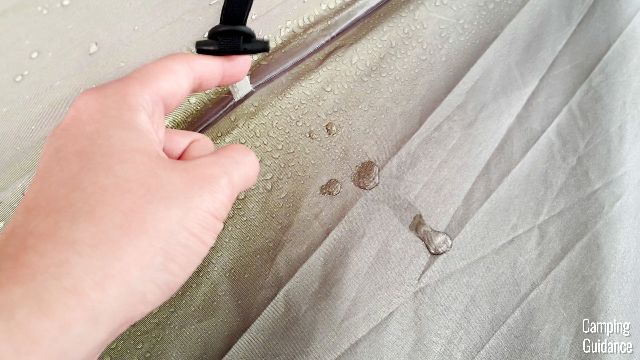
Also, both the Wawona and Base Camp have aerodynamic dome shapes, while the Wonderland has a massive cabin profile, making it catch wind much more easily.
And the Wonderland happens to be the most expensive tent in this review, and its vestibule(s) aren’t even included in the price, unlike the Wawona and Base Camp.
That’s why I’d recommend the Wonderland only if you can score an REI discount on it (this can range from 20-50%, if you’re lucky), and only if you’re mainly a fair and hot weather camper.
The copious amounts of mesh on this family tent will definitely serve you well in those conditions.
Check out the Wonderland 6:
4. Eureka Copper Canyon LX 12 (Best Large Family Tent)
Key Info (for the 6P that I tested)
Peak height: 84 inches
Inner tent area: 93.4 square feet
Vestibule area: None
Setup timing (1P): 14 minutes
Packed size: 29 by 13 by 9 inches
Weight: 22.4lbs.
Pros and Cons
Summary
If you’re looking for the biggest possible large family camping tent, the one I’m gonna recommend is the Eureka Copper Canyon LX 12.
I have the LX 6, which has the same peak height as the LX 12, coming in at a full 7 feet, and this is one of the tallest family tents in this review.
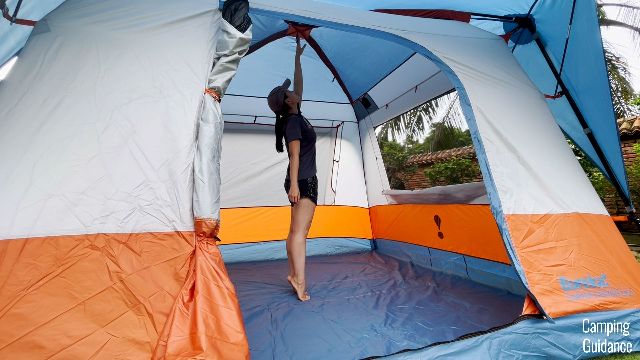
Even after I stretched my arm upwards as much as I could, and I stood on tiptoes at the same time, I still couldn’t reach the top of the tent. The only way I can actually touch the top is if I jump a little bit.
On top of that, I could even stand up everywhere, even at the corners, which had a lowest height of 66 inches. And thanks to the nearly vertical walls, I could walk around everywhere inside the tent.
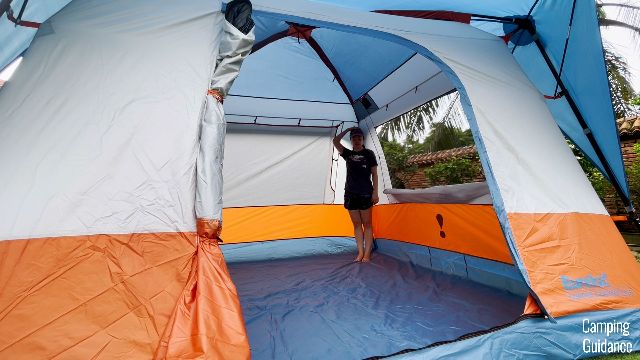
And for a regular setup (non-instant) tent, I found the setup process to be manageable, especially compared to other cabin tents that I have. I could do it completely on my own, and in only 14 minutes. (On the other hand, the Wonderland 6 took me almost 20 minutes!)
The pack away was an amazing experience as well, it was easy for me to push the air out of the tent, and the carry bag is amazing. It’s a top-loading spacious carry bag, and has not just zips but Velcro as well.

One thing you might be wondering here is this – what other brands offer such large family tents? The answer is – not many.
Apart from Eureka, I think only Coleman, Ozark Trail, and Core Equipment have 12-person tents (canvas tents aside). But I’m strongly recommending the Eureka because it’s higher quality than the other 3 brands.
Compared to the more budget tents (Coleman, Core, Ozark), my Eureka has, for example, a lifetime warranty, higher quality materials (like thicker and beefier fiberglass roof poles), and much better waterproofing.
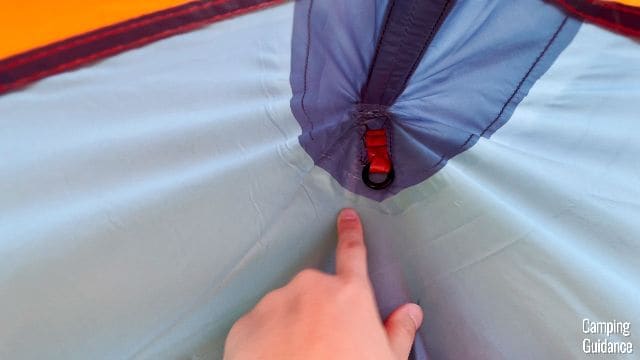
On the other hand, both Coleman and Core have only a 1-year warranty, while Ozark Trail’s is only 6 months. Their fiberglass poles are also much thinner, the materials are cheaper, and waterproofing isn’t as good.

Pricing-wise, the Eureka isn’t as cheap as the more budget brands, but it isn’t too expensive too.
And that’s why the Eureka Copper Canyon LX 12 is easily the very best large family tent out there.
However, just take note that this tent tends to catch wind pretty easily.
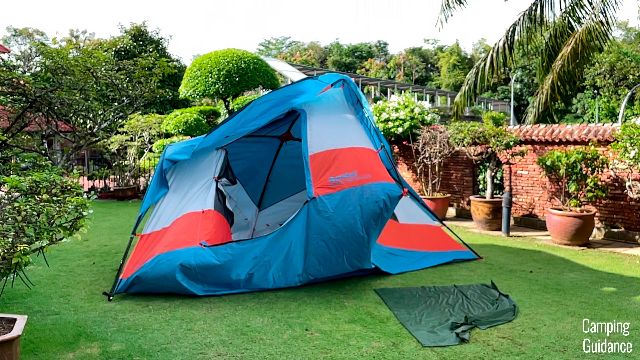
My LX 6 already has a pretty massive profile, so when I don’t stake it down, it’ll blow away in a very light wind (at most 5mph). So, just keep your tent staked down and guyed out.
Check out the Eureka LX 12:
5. Gazelle T4-T8 Hub Tents (Best Instant Family Tent)
Key Info (for the T4 I Tested)
Peak height: 77.5 inches
Inner tent area: 61.0 square feet
Vestibule area: None
Setup timing (1P): 5 minutes
Pack away timing (1P): 6 minutes
Packed size: 68 by 13 by 10 inches
Weight: 34.0lbs.
Pros and Cons
Summary
If you’re looking for the best instant tent instead, that’s easily one of the Gazelle tents. For now, I have only the Gazelle T4 Hub Tent, so my data and testing will focus on that particular model.
Of all the family tents in this video, the Gazelle sets up the fastest, and nothing even comes close. It also packs away the fastest as well. Here are some setup and pack away timings of a few other family tents that I tested for this review:
| Family Tent | Set Up Timings | Pack Away Timings |
|---|---|---|
| Gazelle T4 | 5 minutes | 6 minutes |
| Caddis 6 | 9.5 minutes | 7.5 minutes |
| Sundome 6 | 11.5 minutes | 10 minutes |
| Core Instant 9 | 12 minutes | 9 minutes |
| Eureka LX 6 | 14 minutes | 12 minutes |
| The Others | 16-28 minutes | 13-17 minutes |
The Gazelle has completely pre-attached poles, so all I had to do was to pop open the 5 hubs around the tent, and this tent almost literally just ‘pops open’.
And unlike every single instant tent that I’ve tested, the Gazelle has a removable flooring. So, when packing away the Gazelle, the air comes out super easily, making it easy to compress and stuff it back into the carry bag.

On top of this, the Gazelle’s peak height is massive for a 4-person tent, coming in at 77.5 inches. The lowest height comes in at a whopping 67 inches as well (which is taller than my height of 5’3!), it also has completely vertical side walls, so I could literally walk around everywhere inside the tent.

I could also fit 4 people perfectly into this tent, here are 2 double pads in my Gazelle, and I still had a little leftover space. For 3 people, this tent is surprisingly spacious.

My Gazelle T4 is also probably my only 4-person tent to have 2 doors, 6 pockets (huge ones at that!), and even a gear loft.

It’s also made out of the thickest and highest quality materials I’ve seen in a camping tent. The flooring is 300D polyester, while the tent body and rain fly is 210D polyester. That’s way thicker than even the likes of The North Face (#1 above) and REI Co-Op (#2 and #3 above).
And if you need to fit your family of 6 into this tent, don’t worry because the Gazelle Hub Tent comes in a T8-size. This is literally just double the T4, but thankfully the price doesn’t double (lucky for us!)
I don’t have the Gazelle T8 yet, but here’s what it looks:
However, the biggest con is that the packed size is humongous. It’s the only car camping tent I’ve seen so far that has a packed size that’s taller than me. This is not a tent where you can lug it far away from your car.
Check out what it looks like when I’m standing beside it:

Check out the Gazelle T4:
And here’s the Gazelle T8:
6. Gazelle T4 Plus Hub Tent (Best Screen Room Tent)
- Large main entrance, 1 D-shaped door, 5 windows
- 110 square feet of floor space, including a screened-in second room
- Weight: 56 pounds
- Waterproof 210 denier Oxford weave polyester
- UV50+ rating
- Pops up in as little as 90 seconds
- Detachable floors,
- Storage: 2 gear lofts, 5 gear pockets, 6 wall mounted pockets
Key Info
Peak height: 77.5 inches (estimated)
Base area: 110 square feet (marketed)
Setup timing (1P): <10 minutes (estimated)
Weight: 56lbs. (marketed)
Pros and Cons
Summary
In full disclosure, I do not have the Gazelle T4 Plus Hub Tent, because I overran my budget when making this review, and could not afford another tent. (I will eventually get it though!)
But I have tested other screen room tents from more budget brands like Coleman, and I know the key features to look out for.
The most important thing to look out for is whether the screen room panels can be shut. If you take a look at the Gazelle, notice that the screen room panels are fully closable.
This gives the Gazelle’s screen room much better protection in the rain, and is easily the best screen room in rain I’ve seen so far. (Scroll to the second picture to see the closable panels!)
On the other hand, if you buy a screen room from more budget brands like Coleman or Core Equipment, these screen room tents have hardly any rain fly protection for the screen room.
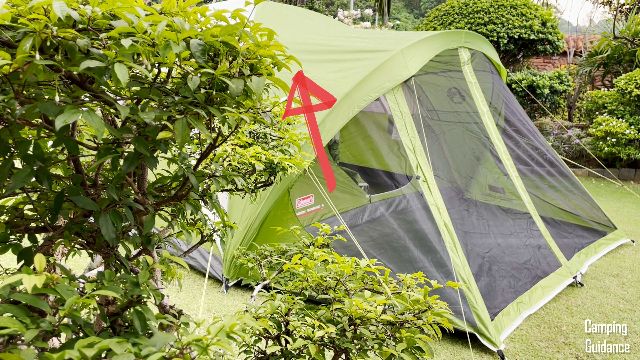
So, even in light rain, water gets into the screen room, not to mention in heavy rain. If you want this to be protected, you’d need to set up an extra tarp over the tent.

Another important feature is this – notice how Coleman’s screen room tent tends to slope down and not offer quite as much livable space?
For example, the peak height in the Coleman Evanston 6’s inner tent is about 68.5 inches. However, in the screen room, the peak height is only about 62 inches, and it slopes down quite a bit after that.

On the other hand, the Gazelle T4 Plus Hub seems to maintain its peak height across the entire tent.
Also, like the Gazelle T4 Hub Tent (without the screen room) that I have, the Plus Hub Tent also sets up extremely quickly, thanks to all the pre-attached hubs and poles of the tent. I’d estimate it’ll take slightly less than 10 minutes (which is slightly less than double the time of the T4).

In contrast, the Evanston took me about 17.5 minutes to set up.
But of course, with all the pros of the Gazelle, the biggest con is naturally the more expensive price-tag. It retails for almost $600, while I paid only about $100+ for my Coleman Evanston 6.
So, if you don’t have a large budget, I’d recommend you go for one of Coleman or Core’s screen room tents instead. I personally like Coleman’s Evanston (I have the 6-person model here), mainly because it’s a really great price, and makes for a great budget screen room tent.
Check out the Gazelle T4 Plus:
Check out the Evanston (budget pick):
7. Core Equipment Instant Cabin 9 (Best Budget Instant Tent & Best Large Instant Family Tent)
Key Info
Peak height: 75.5 inches
Inner tent area: 118.1 square feet
Vestibule area: None
Setup timing (1P): 12 minutes
Packed size: 46 by 13 by 12 inches
Weight: 30.0lbs.
Pros and Cons
Summary
If you found the Gazelle tents too expensive (the T4 cost me $400+, while the T8 comes in at about $500-$600), well, you’re still in luck, because I found Core Equipment to offer great bang for your buck instant tents.
There are also not that many budget-friendly options when it comes to large instant cabin tents of at least 9-, 10-, even 12-person capacities. Not a lot of brands supply them, and the main ones are from Core Equipment, Coleman, and Ozark Trail.
And I found that this Core Equipment Instant Cabin 9 beat out its competitors. Check out this table below comparing my Coleman 10-person instant tent and this Core tent (I tested both of them thoroughly!):
| Instant Tent | Peak Height | Wall Angle | No. of Hubs |
|---|---|---|---|
| Coleman 10 | 73.5 inches | 35° | 1 |
| Core 9 | 75.5 inches | 15° | 3 |
First, even though the Core has a slightly smaller 9-person capacity, it has 2 inches more peak height than the Coleman.

Second, the walls of the Coleman were so slanted, coming in at a whopping 35-degree angle. On the other hand, the Core walls slanted at just a 15-degree angle, which is much better.
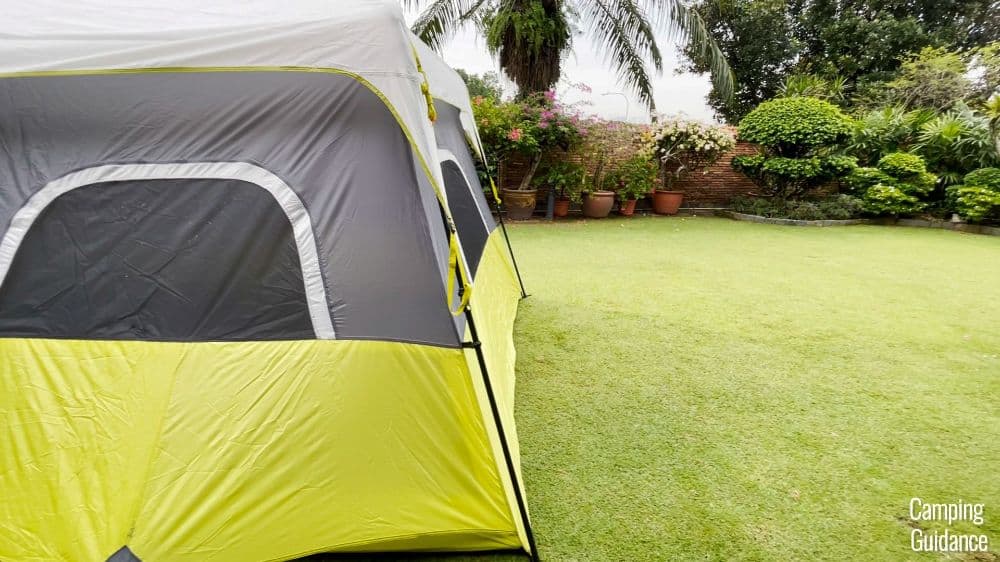
That’s because the less slanted the walls, the more livable space you would have inside the tent.
And third, the Core has 3 hubs at the top of the tent, while the Coleman has just 1 hub. (The more hubs, the more livable space you would have in the tent, because the hubs help hold the tent body fabric up.)

And my Ozark Trail Instant 6 was so bad, I didn’t even feel the need to test it against the Core. (Its peak height was really bad at just 65.5 inches, the walls were also extremely slanted at a 30-degree angle, and it also has only 1 hub. This didn’t even feel like a spacious cabin tent at all.)
Based on the reasons above, I found Core Equipment’s instant tent mechanism to be really great quality, especially for the relatively low price I paid for it.
Also, compared to my other large instant tents, the Core Instant 9 actually had slightly better setup and pack away timings. Check these timings out:
| Family Tent | Setup Timings | Pack Away Timings |
|---|---|---|
| Core Instant 9 | 12 minutes | 9 minutes |
| WeatherMaster 10 | 19 minutes | 16 minutes |
| Montana 8 | 22 minutes | 14.5 minutes |
| Core Cabin 10 | 22 minutes | 13 minutes |
| Columbia 10 | 28 minutes | 16 minutes |
I felt that the Core’s instant mechanism was smoother and more user-friendly than Coleman’s, because sometimes I would have issues with my Coleman instant mechanism jamming up. I never had the same issue with the Core.
Also, Core’s carry bag is much larger than both the Coleman and Outdoor Products, giving me way more space to pack the tent away without any huffing and puffing.

However, as for cons, I felt that the 9-person sleeping area was a little bit strange, and there wasn’t enough room for me to fit 3 queen mattresses in. I could fit only a maximum of 2 queens.

And also, there’s only 2 pockets and 1 lantern loop in the tent. I usually expect a 9-person tent to have at least 9 pockets.
But overall, I really loved the pros of a decent quality, large, instant tent for a budget price, and that’s the main reason why I’m recommending the Core Instant Cabin 9, over anything else from Coleman or Ozark Trail.
Check out the Core Instant 9:
8. Coleman Sundome 6 (Best Budget Family Tent)
Key Info
Peak height: 74.5 inches
Inner tent area: 92.6 square feet
Vestibule area: None
Setup timing (1P): 11.5 minutes
Packed size: 27 by 12 by 9.5 inches
Weight: 16.0lbs.
Pros and Cons
Summary
The Coleman Sundome 6 is easily my best budget pick for a cheap family camping tent.
At a price of just slightly over $100, which is how much I paid for my Coleman Sundome 6, this is easily the least expensive decent-quality budget camping tent.
The construction is fairly solid, and the seams aren’t quite as haphazard as I’ve seen in other budget tents or no-brand camping tents.
As for space, you can technically fit 6 family members in here, but to be a little bit comfier, I’d recommend no more than 4 adults in here, 2 on each queen bed. (This Sundome fits 2 queens!) That’s still enough space for a small family.

I also really liked the 6-foot peak height, with a decent amount of headroom. I’m able to stand upright, stretch my arms out, walk around the tent a little bit, stand up on my pads and mattresses, even jump around, and basically just got a decent amount of livable space for a budget dome tent.

I also found the set up pretty easy, taking me just about 11 minutes on my own, even though I’m not very tall.
The take down and pack away was easy as well, and the carry bag can even be expanded to give you an ample amount of space to stuff the packed-up tent in.

And if you’re willing to spend a few extra bucks, the Coleman Sundome 6 also comes in a Sundome Dark Room 6 model, which is fantastic. (I really love Coleman’s dark room technology.)
It actually manages to block out quite a bit of sunlight for me, and kept me cooler in the day than in a regular Sundome. This was really perfect for me for hot summer days.

But of course, for the price that you’re paying for this inexpensive tent, don’t expect top-notch quality materials. The flooring is budget-quality polyethylene, and the tent body and rain fly are no thicker than 68D to 75D polyester.
Also, like most budget camping tents, not many seams in the Sundome will come factory taped. And in this condition, I found that the Sundome was able to last only 30 minutes in very heavy rain.
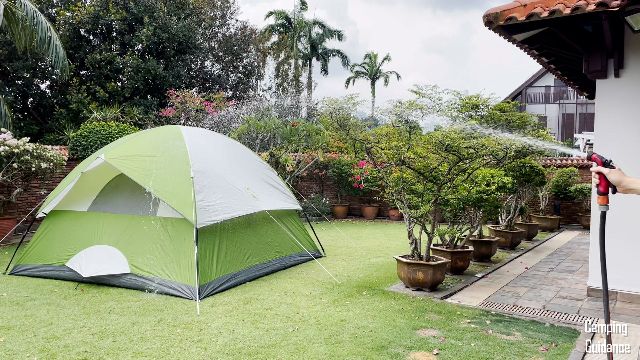
If you’re going to be camping in hours of heavy rain, you’ll have to not only waterproof all the seams yourself, but also coat the entire tent in a waterproofing spray.
Check out the Sundome 6:
Check out the Sundome Dark Room 6:
9. Core Equipment Straight Wall Cabin 10 (Tallest Family Tent)
Key Info
Peak height: 90 inches
Inner tent area: 135.8 square feet
Vestibule area: None
Setup timing (1P): 22 minutes
Packed size: 29 by 16 by 12 inches
Weight: 30.5lbs.
Pros and Cons
Summary
The biggest reason I love the Core Straight Wall Cabin 10 is for its peak height, which comes in at a whopping 90 inches.
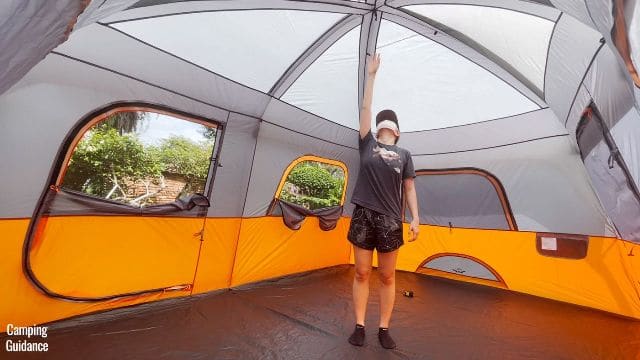
I measured the peak height of every single one of the family tents I tested (and I’ve tested about 30 different family tents now!), and nothing even comes close to the Core. Here’s a quick summary on some of the tallest family tents I’ve tested so far:
| Family Tent | Peak Height |
|---|---|
| Core Cabin 10 | 90 inches |
| Eureka LX 6 | 84 inches |
| Wonderland 6 | 81 inches |
| WeatherMaster 10 | 80.5 inches |
| Columbia 10 | 80 inches |
| Gazelle T4 | 77.5 inches |
| The Others | 68-77 inches |
One thing though, if you’re not tall, like me (I’m only 5’3), you might find this peak height a little too tall.
I couldn’t reach the top of the tent, so every time I wanted to hang a lantern, or get something in the gear loft, I had to stand up on a chair to reach it.

My bro could reach it perfectly fine though, and he’s about 5’7, so I’d recommend this peak height only if you’re at least his height.
The Core Cabin 10 also has pretty vertical and tall walls, with a lowest height of still a whopping 65 inches (this is still taller than my height!), so you get a really spacious cabin tent overall.
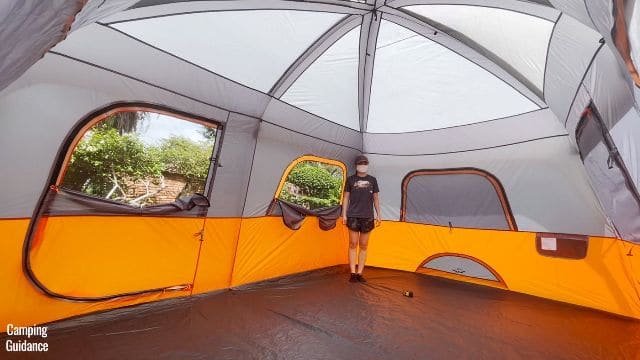
And at an affordable price at that. (I paid just slightly over $200 for this tent.) Core Equipment is, after all, a more budget-friendly brand for more budget-conscious campers.
But apart from the spaciousness and affordability of this tent, there’s nothing else that’s really outstanding about this tent.
For example, this Core tent:
Doesn’t have that much storage (2 pockets, 1 gear loft, 1 lantern loop).
Doesn’t have amazingly huge doors or windows.
Doesn’t have a great room divider.
Doesn’t have fantastic weather resistance.
Doesn’t have a super-quick setup and pack away.
On all these other factors, it’s just an average car camping tent.
I’d recommend this Core Cabin 10 only if you’re big on affordability, spaciousness and a tall peak height, and you don’t mind an otherwise no-frills tent.
Check out the Core Cabin 10:
Otherwise, the rest of the family tents I’ve recommended might be a better pick for you. And again, here’s a quick summary of all the best family camping tents that I recommend:
The North Face Wawona 6: Overall Best Family Tent & Best Weather Protection
REI Co-Op Base Camp 6: Runner-Up Family Tent & Best Off-Season Family Tent
REI Co-Op Wonderland 6: Best for Fair and Hot Weather
Eureka Copper Canyon LX 12: Best Large Family Tent
Gazelle T4/T8 Hub Tents: Best Instant Family Tent
Gazelle T4 Plus Hub Tent: Best Screen Room Tent
Core Equipment Instant Cabin 9: Best Budget Instant Tent & Best Large Instant Family Tent
Coleman Sundome 6: Best Budget Tent for Families
Core Equipment Straight Wall Cabin 10: Tallest Family Tent
Other Best Family Tents on my Wish-List
Here are some other best family tents that I have my eye on, and would love to buy when I come across some extra cash:
Nemo Aurora Highrise – This has been highly requested by my YouTube viewers!
Big Agnes Bunk House – A cabin tent with a full rainfly, which is rare.
Mountain Hardwear Mineral King – I’ve always associated Mountain Hardwear more with mountaineering rather than regular car camping (I’m just one of the regular car campers!), but given the hype, it makes me want to try it out.
Snow Peak Alpha Breeze – Japanese products for the win!
Kelty Wireless – I had the Kelty Salida in the past, and loved it.
Feel free to reach out on my YouTube channel to give me more recommendations, and also let me know why you’re recommending any particular tent!
How I Tested the Best Family Tents
I go about testing all of my best camping tents (family tents, car camping tents, backpacking tents, etc.) in a very similar manner, so this gives me quantitative results that allows me to fairly compare one tent to another.
Here are the 7 main tests that I usually put all my tents through.
RELATED: How to Choose a Family Tent
I. Ease of Use
My ease of use test usually comprises of the ‘ease of setup’ test and the ‘ease of pack away’ test.
The ‘ease of setup’ test involves me timing myself setting up the entire tent, from taking it out of the carry bag, to getting everything set up, including all stakes and guylines.

The ‘ease of pack away’ test is just the exact opposite, from taking down all stakes and guylines, to getting everything back into the carry bag.

For family tents, the ‘ease of setup’ test is more important, because these are all pretty big tents (as most family tents are), and some folks may struggle to put them up.
The setup timings of all the car camping family tents in this review range from 5 minutes (Gazelle T4 Hub Tent) to 22 minutes (Core Straight Wall Cabin 10).
Also, the more features a tent has (like vestibules), the longer it’ll take to set up.
For example, a regular no-vestibule Coleman Sundome 6 takes 11 minutes to set up, while The North Face Wawona 6 with a huge vestibule takes a whopping 20 minutes to set up. Each of these is a six-person tent, but they have drastically different setup timings.
II. Spaciousness
For the second spaciousness test, here are a number of sub-tests that I usually conduct:
Peak height – Is the peak height as marketed?
Lowest height (for cabin tents only)
Side wall angles (for cabin tents only)
Base area of the inner tent – Does it fit as many sleeping pads in its interior space as marketed?
Vestibule area (if any) – Is it as big as marketed?
Total floor space (inner tent + vestibule) – How much overall usable space?

Somehow, I noticed that for family tents, only the more expensive ones (from The North Face, REI Co-Op, Marmot, Nemo, Big Agnes) come with vestibules.
In fact, only 2 tents in this review (The North Face and REI) come with vestibules.

And also, huge vestibules are usually a luxury only reserved for car camping tents. They tend to really increase the weight, packed size, and setup complexity.
III. Comfort and Features
Generally, the more features (and the higher quality the features are) in a car camping tent, the better the tent’s functionality, and the more comfortable the camper would be.
Here are some features that I look out for:
Door quality and user-friendliness
Number of storage pockets
Number of gear lofts
Number of lantern loops
Presence of a power port
Number of room dividers
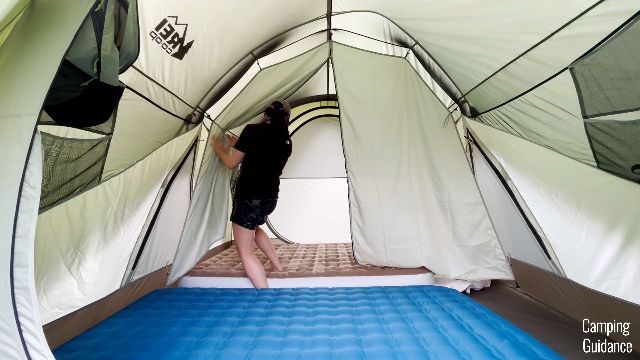
The most important feature I usually like to focus on is the doors, so the first bullet-point above. In just this sub-test alone, I look at various different aspects, such as:
Number of doors
Size of each door
Do I have to duck when getting through each door?
Can I unzip or zip the door one-handed?
How long does it take me to zip the door up?
How long does it take me to unzip the door, and stow the door fabric away?
Is the door snaggy?

I also noticed that only the more expensive family tents come with better quality doors (REI Co-Op, The North Face, Gazelle), while most of the budget-friendly car camping tents (Coleman, Core) are more snaggy and less user-friendly instead.
Also, the pricier family tents tend to have 2 doors (and large doors at that), while the more budget ones have only one door (usually much smaller too).
Pricier tents also come with more storage pockets and options (the Base Camp has 14 pockets and 20 loops!), and better room dividers.
But these expensive car camping tents somehow don’t usually come with power ports. My Wawona and both REI tents didn’t. (Strange. I’d expect these tents to be used in a campsite with electricity, not in the backcountry.)
IV. Ventilation
When it comes to ventilation, I usually test each best camping tent in 2 different conditions:
Hot day ventilation
Rainy day ventilation
Amount of Mesh
On hot days, I like to remove the rainfly and see how much mesh each tent has. I also like to open all the windows and doors for maximum ventilation.
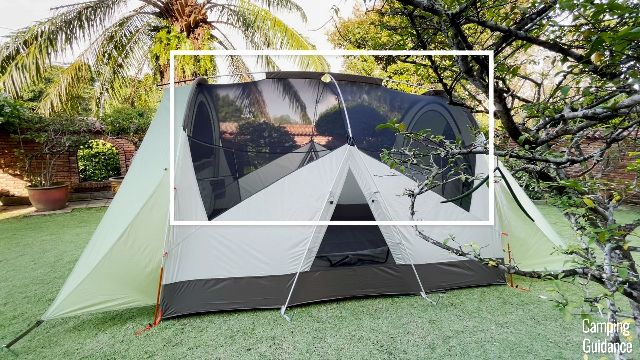
I’ve heard that mesh tends to be more difficult and expensive to manufacture than fabric, so more expensive tents usually would come with more mesh.
For example, my REI Wonderland came with an insane amount of mesh all over the tent. In contrast, a less expensive tent like the Eureka would have less mesh.
Family Tents V.S. Backpacking Tents
Another thing I noticed here is that because family tents have such a massive profile, they tend to have a lower percentage of mesh than a smaller camping/backpacking tent.
For example, my Wonderland has the most mesh for a family tent, and that comes in at about 50%.
On the other hand, some of my smaller camping/backpacking tents can have as much as 80% mesh.

Rainy Day Ventilation
And on rainy nights/days, I like to see how many windows I can leave open in the rain, as well as the presence of any vents for increased airflow.
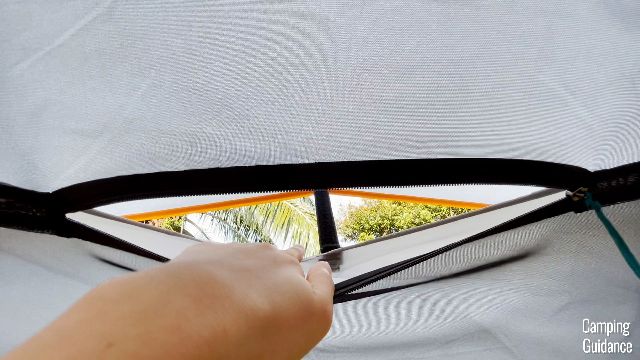
Again, more expensive family tents tend to have better-placed more user-friendly vents, and things like awning over windows so that they can be left open in the rain.
My REI Base Camp 6 has 4 vents that I could open and shut from the inside of the tent, and my REI Wonderland has tiny awnings over its windows.
V. Weather Protection
Rain Test
For rain protection, the 2 important things I like to look at are the length of the rainfly and also how well each family tent has been factory taped.
Naturally, the best tents in rain (and therefore the more expensive family tents in this review) come with completely taped seams and great coats of waterproofing.
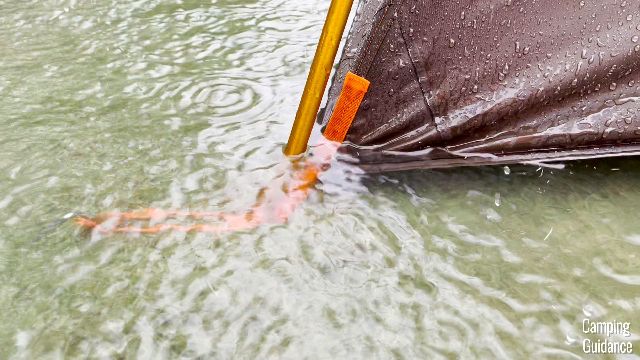
However, only the REI Base Camp came with a full rainfly, which I think is quite a rare feature for family tents.
Wind Test
And as for wind, these are typically the important things to look at:
Tent shape (dome tents are much better in wind than cabin tents with vertical walls)
Material of tent poles (DAC MX like what the Wawona has is the best, fiberglass like in the Sundome is the worst)
Number of guy lines (the more guylines the better)

Family tents aren’t necessarily the best in extremely strong wind, because of their fairly big profiles and relatively high peak heights. A small 1-person backpacking tent would be able to shed wind much better.
VI. Quality & Materials
For the quality of each camping tent, I usually look mainly at the materials used, as well as the quality of the seams.
Flooring Material
For the materials used, most family camping tents would usually have either a polyethylene or polyester flooring. The different tents in this review have floorings that range from between 75D to 300D polyester.
Tent Body Material
The tent body ranges from between 68D to 210D polyester, depending on how high quality your family camping tent is.
And since family camping tents tend to be car camping tents, usually the thicker the material, the more durable it is, and the longer a tent’s lifespan. This will, of course, add on to the weight of the tent though.
Poles Material
I also noticed that only my 3 more expensive family tents had aluminum poles (Wawona, Wonderland, Base Camp), while my less expensive tents had fiberglass poles (Sundome had 3 poles – 1 roof, 2 tent body – all of them were fiberglass poles).
Stitching Quality
A higher-quality family camping tent also tends to have much consistent stitching and seam taping than most tents that are more budget-friendly.
VII. Portability
All the tents in this review are car camping tents and not backpacking tents (not even for short backpacking trips!), so their weight and packed sizes are usually quite heavy and large.
The lightest and most compact camping tent in this review is the Coleman Sundome 6, and that already comes in at a whopping 16 pounds, and a packed size of 27 by 12 by 9.5 inches.

The heaviest camping tent here is the Gazelle T4, which comes in at a whopping 34 pounds and a humongous packed size of 68 by 13 by 10 inches, despite being only a 4-person tent capacity.
That’s because instant tents tend to have much bigger packed sizes than regular tents without the instant setup. So, if you’re buying an instant family camping tent, don’t expect to be able to take it far away from your car to your campsite.
Why You Can Trust Me
I actually bought, own, used, and tested all of the above family tents.
In fact, for just the 9 family tents in this review alone, I spent a grand total of almost $2,700 buying every single one of them. And that doesn’t even include the other 20+ family tents that I tested and didn’t like quite as much, which didn’t end up in this review.
Altogether, I’ve tested over 30 family tents to make this review.
I’d estimate I spent just south of $10,000 on these tents, and I’m planning to empty my bank account to buy even more of them).
I also spent at least a week testing each tent, setting it up, taking it down, sleeping in it, you name it. That means I’ve spent about 7 months in these family tents.
And with all the time, money, and experience, here’s what I can safely recommend to you:
The North Face Wawona 6: Best Overall Camping Tent & Best Weather Protection
REI Co-Op Base Camp 6: Runner-Up Family Tent & Best Off-Season Family Tent
REI Co-Op Wonderland 6: Best for Fair and Hot Weather
Eureka Copper Canyon LX 12: Best Large Family Tent
Gazelle T4/T8 Hub Tents: Best Instant Family Tent
Gazelle T4 Plus Hub Tent: Best Screen Room Tent
Core Equipment Instant Cabin 9: Best Budget Instant Tent & Best Large Instant Family Tent
Coleman Sundome 6: Best Budget Tent for Families
Core Equipment Straight Wall Cabin 10: Tallest Tent
I hope this helps, and feel free to reach out to me on my YouTube channel if you have any questions. I’m only a YouTube comment away, and I do my best to answer everyone.
